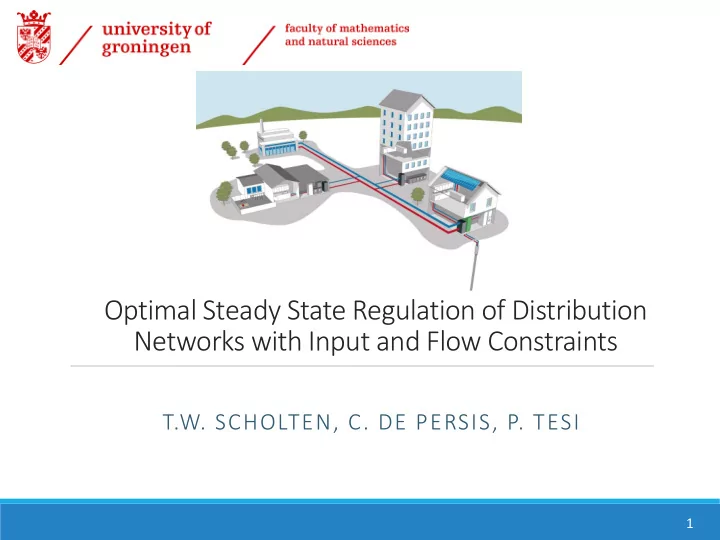

Optimal Steady State Regulation of Distribution Networks with Input and Flow Constraints T.W. SCHOLTEN, C. DE PERSIS, P. TESI 1
Outline Introduction Unsaturated Saturated Conclusion Control goal 2 Motivation Control goal 1 Conclusions Controller Problem Controller Future work design 2 description design 1 Main result Model Stability result Case study 2
Motivation INTRODUCTION UNSATURATED SATURATED CONCLUSION 3
Problem description INTRODUCTION UNSATURATED SATURATED CONCLUSION 4
Problem description INTRODUCTION UNSATURATED SATURATED CONCLUSION 5
Model INTRODUCTION UNSATURATED SATURATED CONCLUSION 6
Control goal 1 Design distributed controllers (flow on the edges) (input at the nodes) and such that where INTRODUCTION UNSATURATED SATURATED CONCLUSION 7
Controller design Flow on the edges suitable gains. Input on the nodes Recall: suitable gains. INTRODUCTION UNSATURATED SATURATED CONCLUSION 8
Closed loop INTRODUCTION UNSATURATED SATURATED CONCLUSION 9
Result 1. undirected graph G is connected If: 2. there exists a of s.t. then Problem 1 Solved INTRODUCTION UNSATURATED SATURATED CONCLUSION 10
Saturation Motivation: INTRODUCTION UNSATURATED SATURATED CONCLUSION 11
Control problem 2 Design distributed controllers (flow on the edges) (input at the nodes) such that given positive with real (arbitrarily small) numbers and for all INTRODUCTION UNSATURATED SATURATED CONCLUSION 12
Controller design Flow on the edges suitable gains. Input on the nodes suitable gains. INTRODUCTION UNSATURATED SATURATED CONCLUSION 13
Closed loop system Steady state deviation from optimum INTRODUCTION UNSATURATED SATURATED CONCLUSION 14
Matching condition Let be the optimal steady state input and a corresponding flowrate. Then, the matching condition is satisfied if INTRODUCTION UNSATURATED SATURATED CONCLUSION 15
Main result If 1. Matching condition is satisfied 2. There exists at least one pair of s.t. 3. The directed graph G is strongly connected 4. The directed graph G is balanced and Details skipped Then Problem 2 is solved INTRODUCTION UNSATURATED SATURATED CONCLUSION 16
Case study: Discharge (volume) Store (volume) Unsaturated flows Saturated flow Optimal input Transient behavior INTRODUCTION UNSATURATED SATURATED CONCLUSION 17
Conclusions • Considered distribution network • Disturbances • Costs associated to input • Controller design • Flows on links • Input on nodes • Considered saturation of flows and input • (practical) stability results • Applied to district heating networks INTRODUCTION UNSATURATED SATURATED CONCLUSION 18
Future work • Remove assumption of balanced graphs • Relax or remove bounds on • Relax restriction • More general model • Including pressures • Algebraic nodes (no storage) INTRODUCTION UNSATURATED SATURATED CONCLUSION 19
INTRODUCTION MODEL CONTROL CONCLUSION 20
Recommend
More recommend